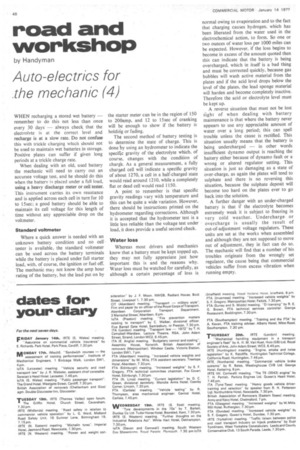road and workshop
Page 50

If you've noticed an error in this article please click here to report it so we can fix it.
by Handyman
Auto-electrics for .the mechanic (4)
WHEN recharging a stored wet battery remember to do this not less than once every 30 days always check that the electrolyte is at the correct level and recharge is at a slow rate. Do not confuse this with trickle charging which should not be used to maintain wet batteries in storage. Positive plates can suffer if given long periods at a trickle charge rate.
When dealing with an old, used battery the mechanic will need to carry out an accurate voltage test. and he should do this when the battery is placed under a full load, using a heavy discharge meter or cell tester. This instrument carries its own resistance and is applied across each cell in turn for 10 to 15sec; a good battery should be able to maintain its cell voltage for this length of time without any appreciable drop on the voltmeter.
Standard voltmeter
Where a quick answer is needed with an unknown battery condition and no cell tester is available, the standard voltmeter can be used across the battery terminals while the battery is placed under full starter load, with, of course, the ignition or fuel off. The mechanic may not know the amp hour rating of the battery, but the lead put on by the starter meter can be in the region of 150 to 200amp, and 12 to 15sec of cranking will be enough to show if the battery is holding or fading.
The second method of battery testing is to determine the state of charge. This is done by using an hydrometer to indicate the specific gravity of the electrolyte which, of course, changes with the condition of charge. As a general measurement, a fully charged cell will indicate a specific gravity of about 1270, a cell in a half-charged state would read around 1210, while a completely flat or dead cell would read 1150.
A point to remember is that specific gravity readings vary with temperature and this can be quite a wide variation. However, there should be instructions printed on the hydrometer regarding corrections. Although it is accepted that the hydrometer test is a little less reliable than the voltage test under load, it does provide a useful second check.
Water toss
Whereas most drivers and mechanics know that a battery must be kept topped up, they may not fully appreciate just how important this is and the reasons why. Water loss must be watched for carefully, as although a certain percentage of loss is normal owing to evaporation and to the fact that charging causes hydrogen, which has been liberated from the water used in the electrochemical action, to form. So one or two ounces of water loss per 1000 miles can be expected. However, if the loss begins to become in excess of the amount quoted then this can indicate that the battery is being overcharged, which in itself is a bad thing and must be corrected quickly, because gas bubbles will wash active material from the plates and if the acid level drops below the level of the plates, the lead sponge material will harden and become completely inactive. Therefore the acid or electrolyte level must be kept up.
A reverse situation that must not be lost sIght of when dealing with battery maintenance is that where the battery never appears to use any appreciable amount of water over a long period; this can spell trouble unless the cause is rectified. This situation usually means that the battery is being undercharged in other words insufficient dynamo output is reaching the battery either because of dynamo fault or a wrong or altered regulator setting. This situation is just as damaging as a state of over-charge, as again the plates will tend to sulphate and there is no reversing this situation, because the sulphate deposit will become too hard on the plates ever to go back into the solution.
A further danger with an under-charged battery is that if the electrolyte becomes extremely weak it is subject to freezing in very cold weather. Undercharge or overcharge is usually the result of out-of-adjustment voltage regulators. These units are set at the works when assembled and although they are not supposed to move out of adjustment, they in fact can do so. The mechanic will find that a number of his troubles originate from the wrongly set regulator, the cause being that commercial vehicles suffer from excess vibration when running empty.
















































































































